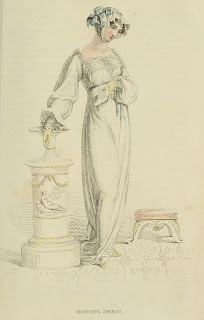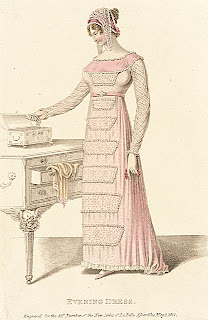The Walking Dress (right) is a white Indian robe of Muslin, made high in the neck; with a richly worked collar to turn over that of the pelisse, which is of blue silk, trimmed with white lace; over which is worn a white,or coloured shawl; the bonnet to be of the same materials as the shawl, and is ornamented with a white feather;–laced half boots of regency brown.
A superfine Scotch or French cambric, over a cambric slip, with full long sleeves, and ruff à la Mary Queen of Scots. A neck-chain and sight set in gold; bracelets and necklace of white or red cornelian. A Flora cap, composed of white satin and lace. A capuchin or French cloak of blossom satin or Pomona green, trimmed with thread lace. Slippers of pale pink or green kid; and gloves of tan or Limerick kid.
A French frock of fine plain India muslin, with demi-train, and long full bishop’s sleeves. Waggoners’ cuffs, with gaged front, and shoulders to correspond. Tucker of double-rolled muslin, which also finishes the cuffs round the hands. A Parisian mob cap of fine lace, confined round the head, and terminating on one side with a celestial blue or silver grey ribbon. Sash of the same, tied in small bows and ends in front. Hair in waved curls, divided in the center of the forehead. Spanish slippers of lemon-coloured kid, and gloves of the same material. The peculiar taste and elegant simplicity of these habiliments are further specimens of the graceful invention of the celebrated Mrs. Gill, of Cork-street, Burlington-gardens, from whom we have obtained them.
A round robe of jaconot or fine cambric muslin, with long sleeve and high waist, with fan ruff of lace, ornamented up the front with borders of needle-work or lace, and finished at the feet with ball fringe. A Spanish hussar clock of deep amber sarsnet, lined with sea green or white, and trimmed with broad thread lace, put on very full. Hair disposed in bands and waved curls; a large square veil of white lace, thrown over the head and shading the face. Half-boots amber-coloured kid, and gloves a pale primrose. Small French caps of lace, ornamented with a small cluster of spring flowers, on one side, are often seen in this style of costume, and have an appropriate and pretty effect beneath the long veil.
oidered crape round robe, decorated at the feet with a deep Vandyke fringe; short melon sleeve; bosom and back to correspond. White or blossom satin under dress. Hair a dishevelled crop, ornamented with a small cluster of the Chinese rose on each side, and confined with a comb of pearl at the back of the head. Necklace, ear-rings, and bracelets, of pearl and wrought gold. Grecian scarf of lilac silk, with embroidered variegated ends. Slippers of white satin, and gloves of French kid. Fan of imperial crape and ivory, embellished with gold antique devices.
Text from Michelle Anne Young’s Regency Rambles
Made of ladies habit cloth or Maria Louisa Blue, trimmed down each side of the front with Spanish buttons, the waist rather long with three small buttons on the hips; a short jacket full behind, the front habit fashion with small buttons up the neck and a row of small buttons on each side of the breast; a lapel thrown back from the shoulders and trimmed with Spanish buttons, has a most elegant effect and gives a graceful finish to the dress. The collar is made about a quarter inch in depth and fashioned negligently at the throat with a large cord and tassel; it opens sufficiently to display the shirt which is of lace in general but this article admits of considerable variations; some of our elegants wear a collar of lace to fall over, others have a shirt edged round the neck with a rich lace frill and not a few, in despite of the heat of the weather, envelope their necks in a large cravat of India muslin. A small woodland hat, whose colour corresponds with the dress with two white ostrich feathers fastened behind and falling carelessly over the left side. A cord and tassel is brought round the hat and fastened near the top of the crown on the right side. Buff gloves and half boots either of buff jean or leather.








